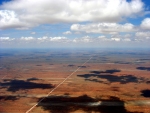For now, I can deliver these comparisons between planar and vacuum sensors:
http://www.apper-solaire.org/2techno.htm
et
http://www.alpilles-solaires.fr/CP_CSV_ ... rtout.html
It's not that easy:
Performance / Price Report:
Once the performances have been calculated, you can then define the quality / price ratio.
You divide the power obtained by the price, then you get a power to the Euro invested.
For the same final power, your budget will be decreased.
Example with DT of 20 ° C located in Paris (vacuum tube collectors):
Sensor A: 280W / m² with a total price for 5m² of 700 Euros.
Sensor B: 230W / m² with a total price for 4m² of 600 Euros.
The reports give for sensor A 2,00W / Euro and for sensor B 1,53W / Euro.
The needs calculations show that you need 1000W average annual time, in this case, a sensor field A will cost you 500 Euros and a sensor field B 650 Euros.
Advantage to the one that is the most expensive (on the label, but -25% compared to the ratio surface / performance).
Example with 30 ° C DT located in Lyon (between 2 sensor technologies):
Sensor A (plan): 390W / m² with a total price for 1,8m² of 300 Euros.
Sensor B (tubes): 350W / m² with a total price for 4m² of 750 Euros.
The reports give for sensor A 2,34W / Euro and for sensor B 1,86W / Euro.
The needs calculations show that you need 1000W average annual time, in this case, a sensor field A (plane) will cost you 430 Euros and a sensor field B (tubes) 540 Euros.
Advantage flat sensor (20% difference anyway, it's not nothing ...).
Example with 40 ° C DT located in Marseille (between 2 sensor technologies):
Sensor A (plan): 340W / m² with a total price for 2m² of 350 Euros.
Sensor B (tubes): 380W / m² with a total price for 5m² of 700 Euros.
The reports give for sensor A 1,94W / Euro and for sensor B 2,71W / Euro.
The needs calculations show that you need 5000W average annual time, in this case, a sensor field A (plane) will cost you 2600 Euros and a sensor field B (tubes) 1850 Euros.
Advantage to the vacuum tube sensor.
We are waiting for the arguments .... mine will be coming soon.




